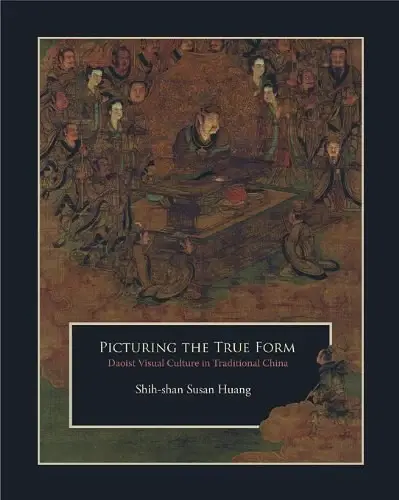
作者:Shih-shanSusanHuang/黄士珊
出版社:HarvardUniversityAsiaCenter
副标题:DaoistVisualCultureinTraditionalChina
出版年:2012-8-27
页数:526
定价:USD69.95
装帧:Hardcover
丛书:TheHarvardEastAsianMonographs
ISBN:9780674065734
内容简介
······
Picturing the True Form investigates the long-neglected visual culture of Daoism, China's primary indigenous religion, from the tenth through thirteenth centuries with references to earlier and later times. In this richly illustrated book, Susan Huang provides a comprehensive mapping of Daoist images in various media, including Dunhuang manuscripts, funerary artifacts, paintings, and other charts, illustrations, and talismans preserved in the fifteenth-century Daoist Canon. True form (zhenxing), the key concept behind Daoist visuality, is not a static picture but entails an active journey of “seeing” underlying and secret phenomena through a series of metamorphoses.
The book's structure mirrors the two-part Daoist journey from inner to outer. Part I focuses on inner images associated with meditation and visualization practices for self-cultivation and longevity. Part II investigates the visual and material dimensions of Daoist ritual. Interwoven through these discussions is the idea that the inner and outer mirror each other and the boundary demarcating the two is fluent. Huang also reveals three central modes of Daoist symbolism—aniconic, immaterial, and ephemeral—and shows how Daoist image-making goes beyond the traditional dichotomy of text and image to incorporate writings in image design. These particular features distinguish Daoist visual culture from its Buddhist counterpart.
作者简介
······
莱斯大学艺术史副教授
1991年获台湾大学学士,1995年获台湾大学硕士,2002年获耶鲁大学博士。黄士珊目前的研究集中于十至十四世纪中国道教和佛教的视觉艺术。在莱斯任教前,她曾在华盛顿大学和哥伦比亚大学执教。她的论文《道教天地水三官及南宋中国(1127-1279)视觉文化的创造》曾获得耶鲁大学Blanshard奖项。著有Picturing the True Form: Daoist Visual Culture in Traditional China(2012),并曾在《故宫学术季刊》、《亚洲艺术》、《道教研究》等发表文章。
目录
······
Machine generated contents note: Visual Dimensions —
Conceptual Framework —
Aniconic, Immaterial, and Ephemeral —
Facets of Daoism —
Primary Sources —
Daoist Tu in the Daozang —
Overview of the Book —
INNER CHAPTERS: ESOTERIC UNDERPINNINGS —
1.Imagery of Body and Cosmos —
Body Gods —
Early Divinities —
Planets and Bureaucrats —
Ritual Activation —
Visualizations of Stars —
Journeys to the Northern Dipper —
Imaginary Star Maps —
Stars in the Body —
Iconic Forms —
Souls and Worms —
The Seven Material Souls and Three Deathbringers —
Physical Parasites —
Control and Elimination —
Illustrating Internal Alchemy —
The Inner Realm —
The Medical Body —
Body Landscapes —
Interior Journeys —
2.Mapping the World —
Daoist Creation —
Sacred Charts —
Heavens and Upper Worlds —
Vertical Heavens —
Lateral Expansion —
Earthly Paradises —
The Ten Continents and Three Isles —
The Five Sacred Peaks —
Grotto Heavens —
Hells and the Underworld —
Mount Fengdu —
Women in Hell —
3.True Form Charts —
Metamorphoses of the Man-Bird Mountain —
Man-Bird Writings —
Birds in Heavenly Scripts —
The Five Sacred Peaks —
The Mystical Cosmos —
The Fengshui Connection —
Mountain Treasures —
Minerals and Herbs —
Magical Mushrooms —
4.Materiality of Daoist Sacred Space —
Forms of Daochang —
The Oratory —
The Public Altar —
Multiple Layers —
Multiple Stages —
Cultural and Religious Sources —
Soul Places —
Ritual Objects —
Flags and Banners —
Mirrors —
Writing Utensils —
Documents —
Spirit Money —
5.Performing the Salvation Ritual —
The Yellow Register Purgation —
Calling Out the Body Gods —
Ascent and Summons —
Attack on Hell —
Opening the Hells —
The Master's Staff —
Artistic Depictions —
Rescuing Souls —
Bathing and Feeding —
The Water Land Ritual —
Salvation through Refinement —
Internal Visualizations —
The External Rite —
Concluding Ceremonies —
6.Paintings of Mobile Deities —
Daoist Painters at Work —
Preparation —
Sketchbooks —
Teamwork —
Priests as Painters —
Three Officials of Heaven, Earth, and Water —
Pictorial Formulas —
Annual Festivals —
Pictorial Conventions —
The Heavenly Descent —
Daoist Deities in Procession —
Visualization Practice —
Earthly Excursions —
Tours of Inspection —
The Subjugation of Demons —
The Tree Goblin and the Ape Monster —
Ocean Crossings —
Crossing Over to Salvation —
Thunder Troops —
The Female Soul —
The Ritual Context —
Mobile Deities —
Yellow Register Painting.
评论 ······
体例模仿道经分内外篇,运用米歇尔"imagetext"的视觉文化理论,将材料还原到仪式和宗教语境,同时也关注佛道竞争带来的交互影响,尤其关注身体-符文-宇宙秩序的象征转换,但是比较遗憾的是更偏重概念式解释,且大量使用明道藏的图像来阐发早其几百年前的视觉性,要是能更多联系考古等实物材料的话,感觉会更好。
作者以具象之图-抽象之文、内在存思-外在仪式、不可见内身-可见宇宙为轴,对道教视觉文化展开了俯瞰式的分析,而“气”则成为流动与贯通此三轴线的中介,凸显出道佛视觉文化的根本差异。而通过将视觉材料主要置于宋代的历史与仪式语境下,也得以窥见佛道之间的紧密互动。
在汲取先前文本、图像与仪式研究的基础上,作者得以展现出一幅流动的视觉文化图景:道士想象神祇不断进出于自身小宇宙与外界大宇宙之间、在神灵的俯瞰视…
從“內”至“外”,各分三章,從“內篇"身體、宇宙觀到真形圖之視覺化(visualization),到“外篇"道儀物質性、空間性和黃箓大醮、天地水三官的相關圖像和儀式情境的復原,層級遞進,互有關聯。作者從頭至尾非常重視佛道兩者在唐宋之間的平行與交集,焦點不斷轉移但十分明晰。總體來說,確實開闢了一個視覺文化的新“洞天”。但由於英文寫作的局限,不少細節和題目需要後來者再深入探究。
前言和结构是真的妙,整本书就像在由内而外构建一个冥想的时空,对我这种外行来说很好进入,从非常实践的角度解释了Poul Andersen那本里很多抽象的定义。比如谈到存想时提到visualization中辅助性的图就像是身体内部的"microcosm, analogous to the time and space of the cosmic world."这种时间性其实是self referent…
评论前必须登录!
注册